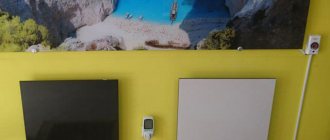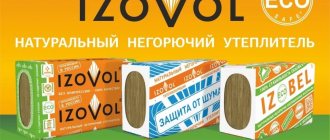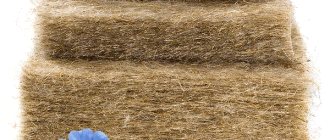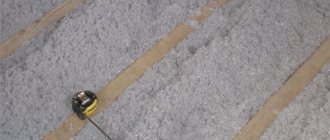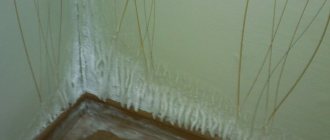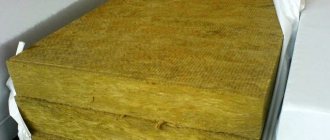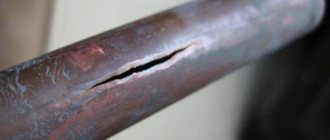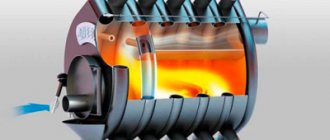What is this technology
The beaches of the Mediterranean Sea are covered with seaweed called Posidonia Oceanica. Previously, this plant was collected and simply disposed of. However, relatively recently it was found that it can do a good job of insulation. As a result of certain treatments, this plant material acquires all the necessary qualities to create an insulating layer.
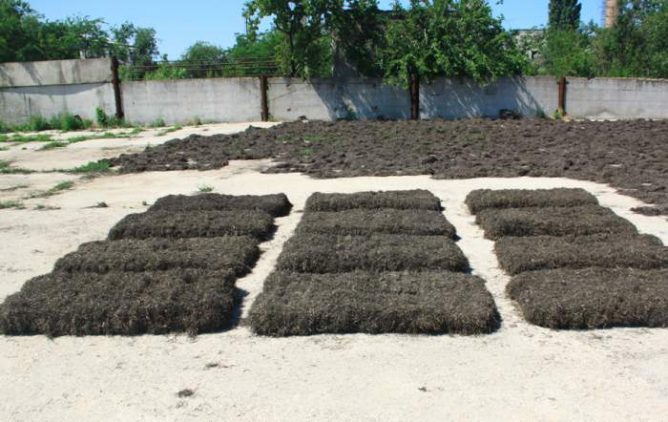
Upon a detailed study of this issue, it was found that a similar technology has been used for several centuries. Residents of coastal areas in warm countries actively dry up seaweed and use it to decorate the roof and walls of houses.
Today, organic raw materials are processed using high-tech equipment. In general, the production methodology is as follows:
- The harvested algae are dried at a certain temperature.
- Then they are placed in a special harvester that provides a very intense shaking. As a result, sea sand is separated from the fibers.
- The cleaned raw material goes under the cutting machine, which crushes it into fibers several centimeters long.
- At the end, the raw materials are separated into fractions and sent to packaging. Most often, rolls are created by pressing and then tying them with strong threads (like glass wool).
Today practically no one makes such heaters on their own, since this is an extremely difficult and burdensome operation. Nevertheless, if you wish, you can implement a similar technology at home, if you have basic equipment.
Natural material that retains heat
During the cold season, on many beaches of the Mediterranean Sea, you can find many fluffy lumps - Posidonia Oceanica seaweed, which is widely known among the inhabitants as the grass of Neptune. As a rule, this plant was collected and taken to landfills, considering it as ordinary garbage.
However, German scientists working at the Fraunhofer Institute, after conducting a variety of studies, found that this material has many advantages that allow it to be used as insulation, replacing traditional mineral or fiberglass.
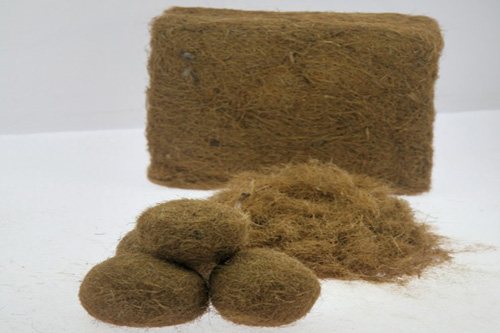

Posidonia Oceanica is a renewable and inexpensive raw material.
At the same time, this plant has the following features:
- does not ignite when exposed to open fire;
- has antiseptic properties - prevents the formation of fungus and mold in their thickness;
- has a low coefficient of thermal conductivity;
- can be used as a heater without additional treatment with chemicals.
Another important quality is hydrophobicity. When the insulation gets wet, it retains its performance, and its fibrous structure contributes to the rapid evaporation of moisture.
Key features of natural heat insulators
Further, in the most objective form, the pros and cons of this organic insulator will be considered.
Dignity
This material, to the surprise of many experts, has very useful properties. Adding modern technologies to them, a good insulation was obtained, which has the following list of advantages:
- Absolute environmental friendliness. This is the main "trump card" of such materials. They are completely safe even for children and people suffering from various allergic diseases.Buildings completely finished with such an insulator are breathable, that is, the natural air balance is maintained.
Important! Even when burning, algae do not emit any harmful substances.
- Does not attract rodents and insects. Surely many are familiar with the problem when mice or rats gnaw through a heat insulator (this is especially true for foam). This forces additional protection measures to be applied. Seaweed is not attractive at all. Moreover, due to the high content of iodine, calcium and some other substances, they even scare away such animals.
- Durability. The natural chemical balance ensures a fairly long service life. However, this is typical only under normal conditions, that is, when various layers are organized and no critical temperature amplitudes or high humidity are observed.
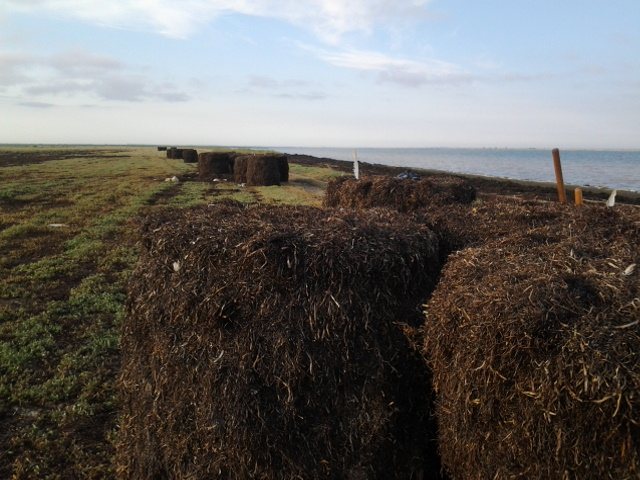

disadvantages
On the websites of manufacturers you can find a lot of information about how effective and practical such heaters are. However, they also have their own serious disadvantages, which in most cases are silent:
- Flammability. Despite the manufacturers' assurances of fire resistance, the dried algae materials burn quite well. Therefore, their use is unjustified from a safety point of view.
- Average thermal conductivity. Such materials belong to class B thermal conductivity (according to Russian GOST). This means that their efficiency is 2-3 times lower than that of "brothers" from class A. Therefore, to create reliable thermal insulation, you will have to increase the thickness of the layer, which is not always justified (especially when it comes to internal insulation, because in this case useful area of premises).
- Poor moisture resistance. In conditions of increased condensation, the thermal insulation will lose its properties, which will reduce its effectiveness. Therefore, it is necessary to create an additional layer of moisture insulation, which is not very rational from an economic point of view.
Stating the above facts, we can state that such a technology is relevant only for regions with a warm climate, because in more severe conditions it will be necessary to create an impressive layer in thickness. She also needs very careful protection from moisture and fire. The use of algae insulation looks reasonable only if the most important criterion for a person is the environmental friendliness of materials. This is true, for example, for people suffering from allergies or respiratory diseases. In all other cases, the use of this ecological insulator is unjustified.
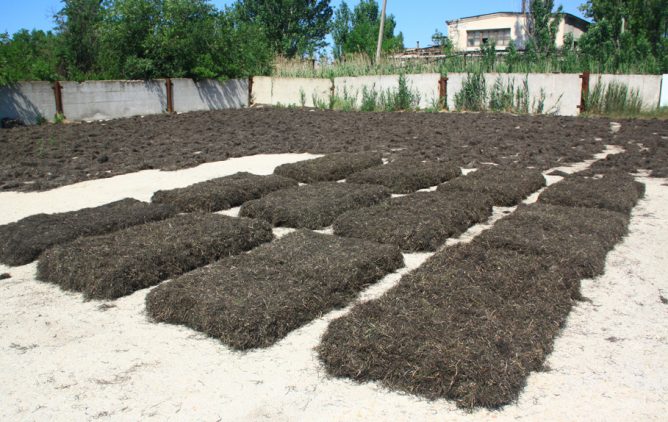

Benefits of seaweed filler
Quilts and pillows with seaweed not only guarantee a restful, healthy sleep, but also have a healing effect on the human body. They are recommended for adults and children as additional health measures in the treatment of a number of thyroid diseases, obesity, osteochondrosis and others. Natural seaweed pillows soothe the nervous system and have a mild immunomodulatory effect on the body.
Algae have bacteriostatic properties, they prevent the growth of bacteria, mold and mites. Therefore, bedding with seaweed filling is suitable for allergy sufferers and people with asthma.
Blankets and pillows filled with algae have a positive effect on the skin, activating the regeneration processes. They promote the elimination of toxins from the body, helping fight fatigue.
The algae filler does not absorb foreign odors and is highly breathable. It does not electrify and does not attract dust. Algae-filled bedding can be machine washed or hand washed.When wet, such a filler does not lose its qualities and withstands multiple washes.
Application Tips
Despite their unusual natural origin, algae insulators are installed using the same technology as mineral wool mats. However, there are a few nuances to be aware of.
- For floor and ceiling finishes, it is recommended to use models sold in bales, that is, loose. It is in this form that the insulator has maximum efficiency, since it allows you to fill absolutely all the space, while leaving a layer of air.
- Be careful when cutting the mats. Organic materials are not very strong, so you can only cut along the fibers or next to the threads that run through the entire structure of the mat and ensure its integrity. At the same time, it is extremely undesirable to cut them, since in this case the roll will simply fall apart.
- As mentioned above, when using any organic insulation, a waterproofing layer is required. In this case, the most rational solution is a moisture-proof membrane. It not only provides protection against condensation, but also allows the walls to remain "breathable".
- In areas with severe winters, it is not advisable to use organic matter for outdoor insulation. As a result of the influence of low temperatures, it will begin to collapse.
Algae Insulation, Largest Aquatic Insect and Cure for Huntington's Chorea
Innovative insulation
proposed by Russian scientists from the Earth Cryosphere Institute of the Siberian Branch of the Russian Academy of Sciences. It will be made from rock formed from the remains.
diatoms
... Layers of these fossils several hundred meters thick come to the surface in the area of Salekhard and Novy Urengoy, forming the largest deposit in Russia. The new insulation will significantly reduce energy consumption in industry.
***
Chinese scientists have discovered largest aquatic insect
... Outwardly, it very much resembles a dragonfly, only of a larger size.
Corridals
- as they were called - have very developed jaws, but not strong enough to bite through human skin. However, insects use their jaws not at all for protection. They need them during mating to keep the females. And in times of danger, these insects give off a very unpleasant odor.
***
Research Center of an American Company Disney
developed an algorithm that allows you to create almost any toy capable of
rotate on its axis
... The optimal 3D mesh shows you where in the object you need to leave a cavity in order for it to be properly balanced. The researchers found that the created algorithm can be used to create well-balanced static objects with a lower center of gravity. Also, in the future, this technology can be used to create stable mechanical structures, for example, robots.
***
Imagine windows in your home that can regulate
amount ingested
sunlight
, or the windshield of a car, forcing
raindrops
flow down a strictly defined path without disturbing the driver. All this can become a reality thanks to the use of a new material developed by specialists from the Massachusetts Institute of Technology, the prototype of which was made by
wool
some types of animals. It consists of a transparent and flexible silicone base, the surface of which is covered with many tiny "microfibers" of
nickel
... This hair is 70 microns high and 25 microns thick, which is about four times thinner than a human hair. When an external magnetic field is applied to the structure of the material, all hairs order their spatial position, orienting themselves in the direction of the magnetic field lines.
***
Russian geneticists have invented a cure for chorea of Huntington
... This disease is associated with the death of groups of neurons, as a result of which, over time, a person ceases to adequately perceive those around him, his motor functions are impaired. Scientists from the Institute of General Genetics. Vavilov Russian Academy of Sciences found the cause of the disease: it turned out to be
improper regulation of calcium ions
... When a certain substance is used, the exchange of calcium in damaged cells is restored, and the cell ceases to be destroyed. Researchers keep the name of the substance a secret, because it is a know-how, on the basis of which a unique drug will be created in the near future.
What algae are used for thermal insulation
For the production of heaters from algae, two types of sea grass are used - sea scum and dwarf scum. They are collected and harvested on the Black Sea coast, while the algae are thoroughly dried. The popular name of this material is damask.
Blackfish (lat.Zostéra marína) is a perennial herb that grows in the coastal waters of warm seas. Its branched root system forms real meadows under water with a lush cover reaching a meter in height. Blossom flowers are pollinated under water, with the help of water streams that carry pollen.
Such unusual and harsh conditions for plant life contributed to the fact that the grass acquired a number of unique biochemical characteristics.
The plant is used in medicine, furniture and food industries. It is used for packaging and filling for mattresses and pillows. In some countries, this algae is used to make roofs similar to thatch. They are lightweight and durable. The leaf width is about 6 mm.
Are algae suitable for construction purposes?
It is clear that algae for construction needs can be used mainly in the respective regions. For example, in Denmark, which has access to the shallow waters of the Baltic Sea, seafood has long been used to insulate houses. The fact is that there are not many forests, but there are plenty of algae. The latter, as everyone knows, reproduce quickly, without special efforts, especially on the part of humans. Therefore, for a long time, the Danes began to use well-dried seaweed for their modest construction needs.
Moreover, it has already been noticed that the seagrass thrown ashore after drying remains quite soft, burns poorly, does not emit strong odors and serves for a very long time. Who does not know - seaweed has been actively used and is used for stuffing mattresses and pillows. It is very comfortable to sleep on such products, and they do not get lost, like their fellow feathers. What can not be said about river algae, which emit a strong recognizable smell, should they lie on the shore for a couple of days.
Of course, with the development of scientific and technological progress, human attention to algae was weakening. Therefore, only now, after numerous trials and errors, as well as studying the experience of ancestors, in Denmark one architectural studio, together with a small construction organization, was puzzled by the construction of a house using sea vegetation. The project has many supporters, both among environmentalists and among ordinary citizens. After all, the use of the aforementioned material will help clear coastal waters from excess vegetation, reduce carbon dioxide emissions into the atmosphere, and reduce construction costs.
However, it is premature to talk about the widespread introduction of this technology. Unfortunately, until such houses "went into series", they will cost more than their traditional counterparts. And when they go to the broad masses, entrepreneurs will appear who will begin to produce various components for a new type of construction, which will inevitably require the commissioning of some capacities. The latter, unfortunately, will increase the environmental pressure on nature.Such is the double-edged sword.
Another application for algae, but already more advanced, was demonstrated at the International Building Exhibition, held in Hamburg in April 2013. A unique 15-apartment building called BIQ House was erected here. Its uniqueness lies in the fact that the house is partially clad with glass panels of two centimeters thickness, totaling 129 pieces. These panels are nothing more than biological reactors that generate biomass and heat. In the summer, they shade the windows, at night, they create additional noise insulation. The total area of such elements is 200 square meters, and they are mounted from the south-east and south-west sides.
The essence of the functioning of the life support system at home is briefly as follows. In sunlight, algae actively grow and multiply, producing about 5 times more biomass per hectare than terrestrial plants. The resulting biomass in the form of a thick suspension is sent to a reactor with enzymes, where biological gas is produced from it. It is suitable for heating and generating electricity if, say, the house is still warm. According to the plans of the developers, you can go further and accumulate excess heat in deep (up to 100 meters) tanks filled with a special saline solution. Or, for example, to increase the power-to-weight ratio of a house by installing wind farms and solar panels on it.
BIQ House announced the creation of 15 apartments ranging from 50 to 120 square meters. Is this a lot or not enough, considering that the project itself has taken over three and a half million euros? If we talk in momentary categories, then, perhaps, a lot. And in the long run? Nobody has ever lived in such buildings. And he did not exploit them for a considerable time. There are only preliminary estimates that are encouraging.
Well, let's see. It is possible that in ten years such promising dwellings will begin to take their place under the sun. And in the literal sense.
Tags: building materials, innovation, houses, progress, construction, ecology, nature
The main qualities of the insulation from seaweed ↑
Belonging to the underwater world contributed to the fact that kamka acquired the following properties:
- Environmentally friendly and hypoallergenic. The high iodine content not only saturates the human body with this microelement without the risk of overdose, but also ozonizes and disinfects the air.
- Fire safety. The combustion efficiency of the sea grass is zero. Silicon, contained in it in high doses, makes such algae insulation a non-combustible material, more precisely, hardly flammable. Once on fire, the dried algae will simply collapse without causing the fire to grow.
- Non-toxic. The naturalness of the material excludes the release of poisonous gases and toxic substances during smoldering.
- Durability. Properly harvested damask retains its quality characteristics for 150 years. This is evidenced by the conclusions of Danish experts from the architectural bureau Vandkunsten.
- Practicality. Over time, the material acquires water-repellent properties. Due to the content of tannins, seagrass does not cause rotting or drying out of the elements of the roof that are in contact with it, and is not susceptible to the effects of destructive fungi.
- High thermal conductivity. Algae insulation belongs to the medium thermal conductivity (class B) thermal insulators. This has been proven during tests carried out by the Simferopol Academy of Environmental and Resort Construction at the Department of Chemistry of Building Materials. Subject to a certain level of humidity (16-24%) and density (80-90 kg), the thermal conductivity of the material is 0.087 W. For concrete, for example, this indicator is equal to one, mineral wool has a similar parameter. At the same time, the scum is lighter than both of them.
- Sorption properties.The moisture absorption is about 30%. For comparison, synthetic heat insulators have an indicator of only 0.3 - 0.7%. This is another plus in favor of fire safety. And also proof of the ability to regulate humidity in a room and create an optimal microclimate for humans. It does this by absorbing and then releasing the accumulated liquid in dry air.
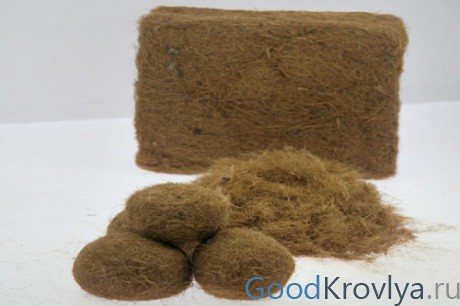

Such a natural algae insulation protects the building from drafts and has good sound insulation. Due to its long stay in sea water, it is not exposed to mold.
An added bonus is that the calcium and sodium salts contained in dried algae are excellent at repelling mice and insects. This is especially true for private homes, sheds and cellars.
How to make algae insulation and its properties
Today you can find many heaters made from various raw materials: basalt fibers, glass, polymer compounds, clay, etc.
A special role is prepared for environmentally friendly materials, which, according to scientists, are even beneficial to human health. These include insulators made from seaweed.
This unusual solution will be discussed below.
What is this technology
The beaches of the Mediterranean Sea are covered with seaweed called Posidonia Oceanica. Previously, this plant was collected and simply disposed of.
However, relatively recently it was found that it can do a good job of insulation.
As a result of certain treatments, this plant material acquires all the necessary qualities to create an insulating layer.
Upon a detailed study of this issue, it was found that a similar technology has been used for several centuries. Residents of coastal areas in warm countries actively dry up seaweed and use it to decorate the roof and walls of houses.
Today, organic raw materials are processed using high-tech equipment. In general, the production methodology is as follows:
- The harvested algae are dried at a certain temperature.
- Then they are placed in a special harvester that provides a very intense shaking. As a result, sea sand is separated from the fibers.
- The cleaned raw material goes under the cutting machine, which crushes it into fibers several centimeters long.
- At the end, the raw materials are separated into fractions and sent to packaging. Most often, rolls are created by pressing and then tying them with strong threads (like glass wool).
Today practically no one makes such heaters on their own, since this is an extremely difficult and burdensome operation. Nevertheless, if you wish, you can implement a similar technology at home, if you have basic equipment.
Key features of natural heat insulators
Further, in the most objective form, the pros and cons of this organic insulator will be considered.
Dignity
This material, to the surprise of many experts, has very useful properties. Adding modern technologies to them, a good insulation was obtained, which has the following list of advantages:
- Absolute environmental friendliness. This is the main "trump card" of such materials. They are completely safe even for children and people suffering from various allergic diseases. Buildings completely finished with such an insulator are breathable, that is, the natural air balance is maintained.
Important! Even when burning, algae do not emit any harmful substances.
- Does not attract rodents and insects. Surely many are familiar with the problem when mice or rats gnaw through a heat insulator (this is especially true for foam).This forces additional protection measures to be applied. Seaweed is not attractive at all. Moreover, due to the high content of iodine, calcium and some other substances, they even scare away such animals.
- Durability. The natural chemical balance ensures a fairly long service life. However, this is typical only under normal conditions, that is, when various layers are organized and no critical temperature amplitudes or high humidity are observed.
disadvantages
On the websites of manufacturers you can find a lot of information about how effective and practical such heaters are. However, they also have their own serious disadvantages, which in most cases are silent:
- Flammability. Despite the manufacturers' assurances of fire resistance, the dried algae materials burn quite well. Therefore, their use is unjustified from a safety point of view.
- Average thermal conductivity. Such materials belong to class B thermal conductivity (according to Russian GOST). This means that their efficiency is 2-3 times lower than that of "brothers" from class A. Therefore, to create reliable thermal insulation, you will have to increase the thickness of the layer, which is not always justified (especially when it comes to internal insulation, because in this case useful area of premises).
- Poor moisture resistance. In conditions of increased condensation, the thermal insulation will lose its properties, which will reduce its effectiveness. Therefore, it is necessary to create an additional layer of moisture insulation, which is not very rational from an economic point of view.
Options and types of thermal insulation materials ↑
Manufacturers offer to purchase sea grass in several forms. Having weighed all the pros and cons, such as the ratio of price, ease of installation and practicality during operation, choose the best option from three possible ones.
Finished heat-insulating plates such as "Fitoizol" or "KamkaS" ↑
The most technologically advanced and easy-to-use form with the price corresponding to the invested labor.
The popular Fitoizol insulation boards on the market are produced by the thermal bonding method, which binds natural and polyester fibers into a single mass. The board consists of 85% prepared algae and 15% organic silicone or casein glue as a binder. Density - 20-50 kg per cubic meter.
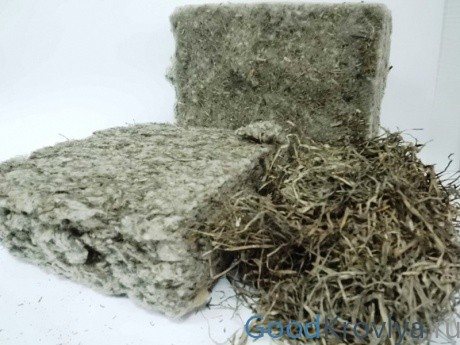

Has the following advantages:
- high performance due to an optimally balanced composition;
- easily cut into pieces of the desired size;
- resistance to weathering and stalling;
- a large selection of slabs of different thicknesses and densities, varying depending on the place of intended installation;
- ease of use: you can choose a ready-made insulation not only for the roof, but also for walls, walls, floors.
Insulation of algae in the form of slabs is suitable for insulating the internal structures of buildings for any purpose. The standard slab size is 1200x600.
Heat-insulating mats in a grid ↑
The option is good, but it requires knowledge to help you make the right choice. Otherwise, you can be disappointed later. A high-quality thermal insulation mat should:
- have a weight of 12-14 kg, with a size of 1000x2000x100, otherwise, you pay for air;
- be well packed, otherwise a half-empty mesh will reach the end user from the manufacturer: weak packing is 20-30% of filling losses during multi-stage loading and unloading operations;
- have cells equal to 80x80, 100x100, 150x150, stitched with high-quality nylon thread.
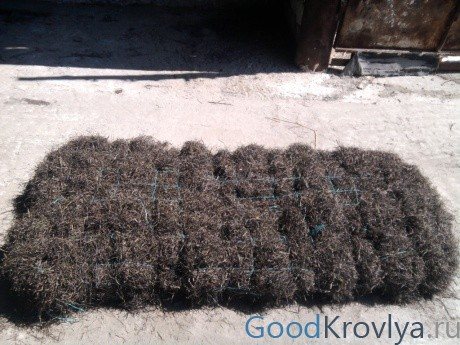

Insulation in mesh mats is a good product, but you should choose it carefully, avoiding dubious manufacturers.
Important! If it is necessary to adjust the size, it is rather difficult to separate such mats. They run the risk of falling apart, so installation will require skill and patience.
Dry seagrass by weight or in bulk ↑
Such algae insulation is produced in pressed rolls or in bales and sold by weight. This is the most budgetary option, which is quite convenient for handling, transportation and storage. The savings of as much as 25% is justified by the fact that the production of this form does not involve the work of knitters, and also does not use threads, as in other options.
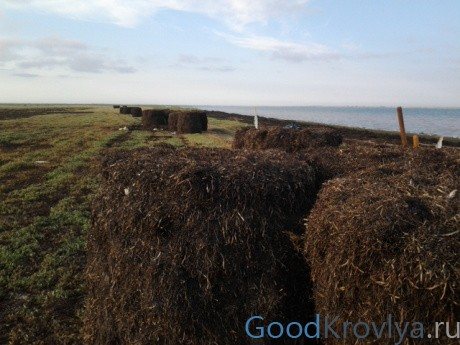

However, they buy loose damask not only for the sake of economy, such insulation can be used in non-standard situations and without thinking about the configuration and size of the insulation area.
An important point during installation is the tightness of the packing. Otherwise, you can get an eco-friendly, but cold home.
Features of laying plant thermal insulation ↑
The seagrass, produced in the form of slabs and mats, is selected and installed based on the recommendations of the manufacturers outlined in the instructions. The material is soft and pliable during installation. To lay a damask purchased by weight, you should follow some of the recommendations and tips below.
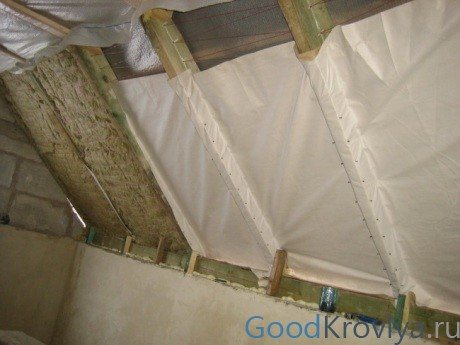

How to calculate the right amount
In order not to be mistaken with the volume of purchased algae for insulation, you can use one of the following methods:
- Method 1. The coefficient of thermal resistance of the part of the building that is planned to be insulated (roof, walls, floor) is calculated in accordance with the region of residence. To do this, it is enough to have basic knowledge in the field of construction, since the calculation itself is simple. After determining the coefficient, it becomes clear which layer the heat insulator will be laid.
- Method 2. If you have difficulty in determining the coefficients, you can use the proven old-fashioned method based on many years of experience. Living in the southern regions can get by with a dam, laid at the rate of 5-6 kg per square meter of roof. For the northern regions, this figure should not be lower than 9 kg per square meter.
Styling secrets or custom sandwich ↑
Roofing is always like a sandwich. By gradually laying out different layers of materials with different properties, a reliable and practical roof is obtained. It should be borne in mind that when using sea grass, the number of layers differs from the standard in a smaller direction, since this building material has the quality of an absorbent.
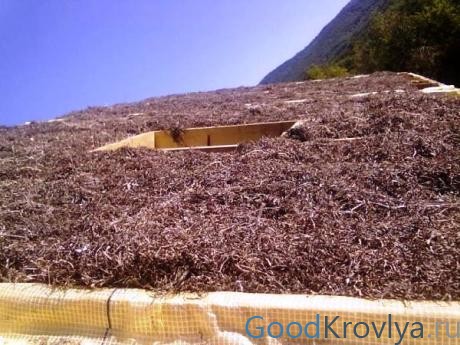

Before laying the insulation, lay a vapor barrier layer. This may be the most inexpensive specialty film. Then the damper itself is mounted, taking into account the required density determined by one of the above methods.
When laying the insulation in bulk, it should be carefully tamped, otherwise it may sag. Particular attention should be paid to the corners and various crevices, which are carefully closed. But to cover such material, imitating a classic sandwich, is impossible. Even with minimal temperature differences, the sorption properties of sea grass will contribute to the creation of the dew point, while at the same time degrading the level of thermal insulation.
Important! When laying, some safety precautions must be observed. The installation standard is the meter distance between the thermal insulation layer and the heating source. This is especially important when building a bathhouse, which is built from dry wood. Here, too, attention is paid to the construction of floors. They must be massive and durable, in no case should they be in direct contact with the damper.
The laid insulation does not tolerate mechanical stress, as it easily breaks down, turning into dust. This should be taken into account during possible roof repairs.
Hemp
For our country, this is a rather exotic insulation, which is due to the peculiarities of the plant itself, which is simply prohibited to grow without special permission. However, on the market you can find German hemp heaters in the form of slabs and rolls of various sizes and thicknesses.By its properties, hemp insulation is very similar to linen, but it can cost a little more.
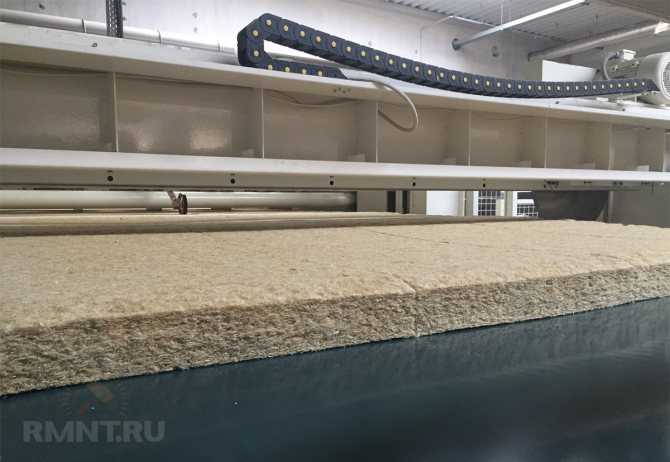

Review of manufacturers of heaters made of sea grass ↑
On the market you can find many companies that produce and sell algae insulation. The most famous of them:
- SoTechS LLC, Moscow, Russia, is an exclusive supplier of Zostera algae from the Karkinitsky Bay from the Crimean coast. Sells damask in bales and by weight.
- LLC "Akvafitoresurs", Moscow, Russia, not only sells, but also independently harvests and processes sea grass.
- • LLC "Enterprise of Nonwovens" (PNM), Mytishchi, Moscow region, Russia, produces thermal insulation boards "Fitoizol".
- LLC "Tira", Moscow, Russia, on the basis of a scum, produces non-woven volumetric natural insulation Flaxan MIX, which also includes flax and lavsan. The material is produced in mats, size 1050x600x50. According to the conclusions of the Netherlands Institute of Building Biology and Ecology (NIBE), its service life is at least 75 years.
- LLC EKO-term, Ukraine (TM EKO), offers bales or mats, size 1000x600x100 (you can order an individual parameter).
- LLC "EkoKambud", Susanino, Ukraine, produces mats from zostera.
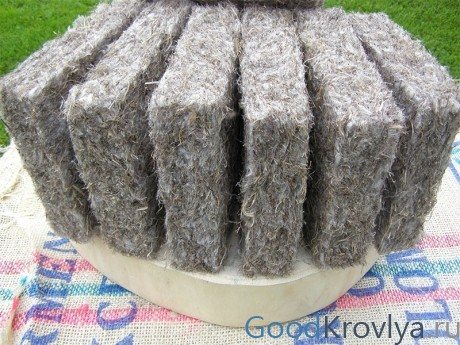

As you can see, there are plenty to choose from. Natural algae insulation has proven itself quite well. If you want to save money, go to the Crimean sea coast to collect zoster with your own hands. If you prefer to use certified products, contact experienced manufacturers who offer not only pure damask, but also its mixtures with various natural materials, such as lavsan and flax.
Insulation from "KAMKA" - myth or reality ?!
Seagrass is a resource whose use makes it possible to intensify industry and agriculture.
Sea herbs have a wide range of applications. They are considered a potential source of raw materials for the creation of food additives, are used in the production of medicines and serve as animal feed (mainly in foreign countries). Livestock eat both fresh and dried seaweed.
In addition, they are widely used for technical purposes as packaging, padding and sound-proofing material, resistant to fire and mechanical damage. Speaking about them, we mean the genus Zoster or Vzmornik (Kamka).
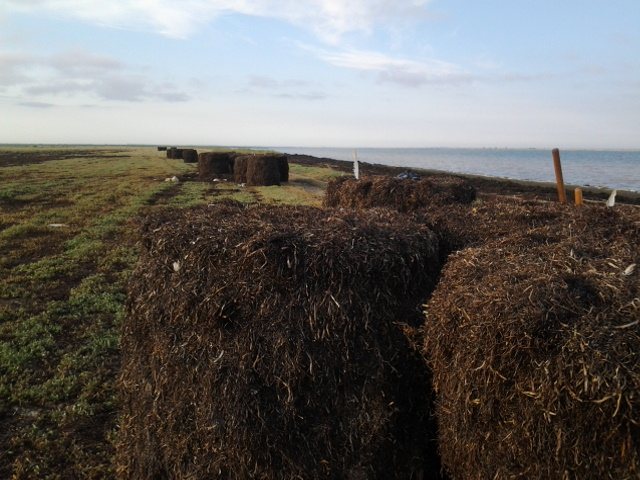

Blackjack. Distribution area
Even in ancient times, mattresses and upholstered furniture, as well as other household items, were stuffed with leaves of a gruel, used as packaging material. Leaves and shoots of zostera, which were carried to the shores by the generous sea, were used as fertilizer for the fields. And the Mexican Indians easily consumed damask in the form of flour.
Kamka belongs to the highest flowering plants that are rarely found in the seas and oceans (their list does not exceed two dozen). During the flowering period, the seagrass is covered with well-aimed white flowers.
Zostera with narrow ribbon leaves grows on sandy soil at a depth of 1-3 meters.
Skamorn is a perennial creeping plant with a flattened rhizome and the same stems, on which leaves are arranged in two rows. Zostera grows in calm waters of bays of different seas (Black, Japanese, Azov). On its meadows fish and sea animals graze, and sometimes even migratory birds.
Physical and chemical properties of Zostera
Hundreds of thousands of tons of sea grasses are washed ashore every year. Only 1% of this amount is used for production purposes. Seafood mainly consists of 2 types of zostera, which shed their leaves in August-September.
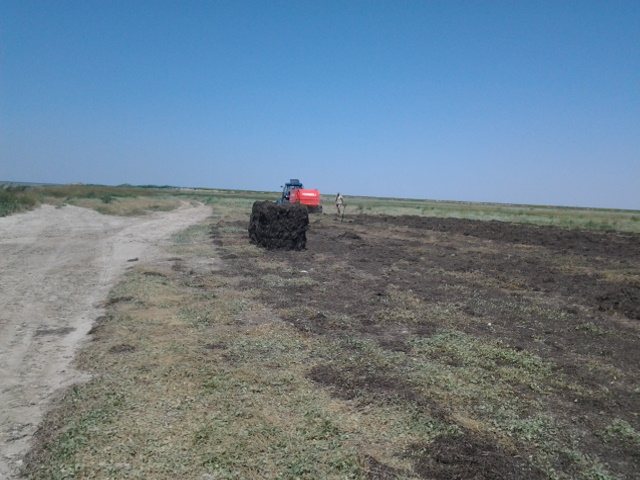

The chemical composition of sea grass is studied in detail in research institutes.Through the efforts of scientists, we learned that zostera contains extractive and nitrogen-containing substances, carbohydrates, minerals and lignin.
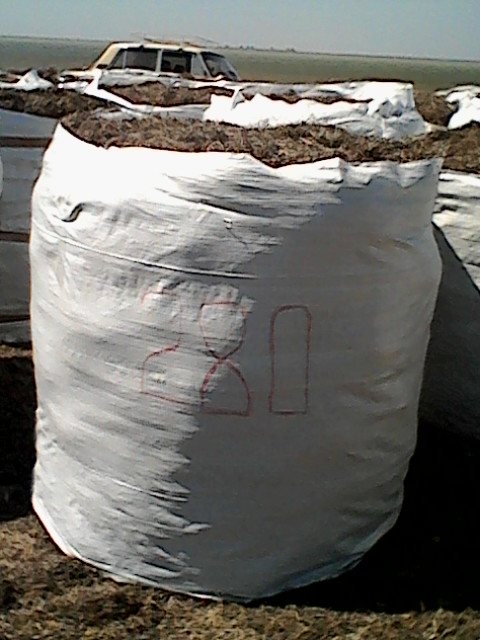

Like other marine plants, zostera is characterized by high ash content, because it accumulates large amounts of minerals. In kamka (as the common people call the herb zoster), micro- and macroelements are combined in optimal proportions. Zostera contains carotene, ascorbic acid and many B vitamins. The high content of iron, calcium, copper and cobalt, the presence of zinc and molybdenum in the composition make kamka an irreplaceable food product for animals.
Zosters in industry
Kamka turned out to be a very promising raw material, and its painstaking study ended with the development of a number of technological processes that led to the creation of means of mechanization and automation of the collection and processing of plants for the subsequent creation of industrial goods. After that, the first children's mattresses with damask filling and new modern heaters appeared. The Moscow Research Institute presented samples of thermal insulation boards for finishing, which became another argument in favor of using Zostera as a raw material in the production of building materials.
At one time, paper was made from damask, and now pectin is extracted from it, which is actively used to obtain marmalade, marshmallow and other gelled products. A large amount of pectins and hemicelluloses allows the Zoster to be used for briquetting and granulating compound feed (as a binder).
Zostera in construction
In Denmark, on the island of Lesso, algae houses have been standing for two centuries. Surprisingly, for the Danes, kamka turned out to be an ideal substitute for wood. It was easy to collect and dry - nature became a reliable supplier of raw materials. And now, centuries later, we can confidently assert that the Danes made the right choice. It is unlikely that we would have seen their creations if the inhabitants of the island used ordinary wood as decoration.
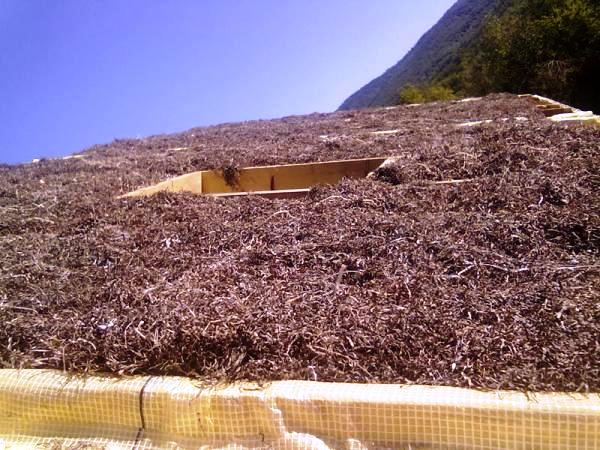

Zostera is the perfect insulation. It is not subject to decay, does not breed mold, pests are afraid of it. Sea grass improves the microclimate and perfectly neutralizes pollution. Over time, the filler becomes even denser and becomes water-repellent. The thermal insulation qualities of kamka are comparable to those of mineral wool.
In modern homes, seaweed is a wonderful filling for timber frames. Zosteroi insulate the roof and floor. If you lay mattresses stuffed with dry algae under the roof, you can “kill two birds with one stone”: insulate the building and create excellent sound insulation. The positive qualities of kamka as a building material (according to experts) remain unchanged for at least 150 years.
Benefits of seaweed insulation
Insulation made from zostera, which grows at the bottom of the seas, is often a stitching mat. It mainly consists of leaves mixed with a small number of stems, which are 20-100 centimeters long. Kamka is tinted brown-green and smells like the sea. It soothes the nervous system and does not lose its beneficial properties even when wet.
Insulation made of sea grass is used for:
A high level of sorption humidification helps to maintain the air humidity that is favorable for humans. In addition, damask contains a large amount of iodine, which saturates the air. As you know, this element has a beneficial effect on the functioning of the thyroid gland.
Algae insulation
Whatever is made from seaweed - salads and pillows, cosmetics and fertilizers, bags and oil ... Imagine insulation, too. Moreover, they have always done it. They collected brown lumps of tangled sea grass thrown ashore by the wave, dried, intertwined. Today, stitching mats are produced from algae, as well as plate, bulk insulation, ladders.
The thermal insulation properties of dry algae are similar to those of wood. But the gifts of the sea, in contrast to the gifts of the forest, are less susceptible to decay, are resistant to fungus and do not support combustion. And also, they say, rodents and insects do not favor them (due to the high salt content). As for competition with inorganic counterparts, for example, modern insulation from the sea plant Zostera, not inferior in thermal conductivity, gives them a head start in resistance to mechanical damage. And 30 percent cheaper than mineral wool!
